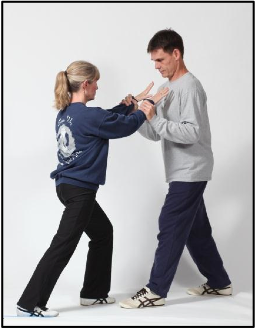Principle One: Use of Intent
The most fundamental and important principle in practicing Taijiquan is the mindful awareness of one’s state of being, and conscious control over one’s structure, breath and movement. The Classics of Taijiquan state the practitioner must “use the intent and not force” when practicing. Here “intent” refers to the conscious awareness of the self, and it’s connection to the kinesthetic sense of the body. No movement is ever made without conscious direction. Once the practitioner is able to feel the entire body, there is the potential for unification between the mind and body and for self-control. The conscious use of the intent brings focus and organization to the thought process, and only then can movement be created in accordance with the requirements of the form practice.
How does the student achieve this state of mind and body unity and the subsequent control of the body? In order to practice unification, the creators of Taijiquan have developed several indispensable tools:
Principle Two: Stillness
If our goal is to unify our mind and body, and bring our posture and movement under conscious control, it is best to start by reducing all variables of practice to a minimum. Obviously, starting the practice with complicated physical gymnastics that demand a high degree of coordination is not the way to go. We first want to pay attention to our physical state and and “feel” our bodies. We need to recognize how our body is aligned, and its intimate relationship with gravity and the earth. So how best to start? It is best to start by standing still. When still, the demands of the practice are reduced to the minimum, we an focus all our attention on simply feeling our body-state and the pressures of gravity. While standing still, we will eventually start to feel the internal rhythms inside our bodies and the influence our breathing has on ourbalance. We can begin to use our conscious intent to gently bring our bodies into harmony with the great forces in our environment, gravity and the earth, so that we can release unnecessary tension and come back to the natural state of balance and ease we enjoyed as children.
If one cannot stand still with correct alignment and relaxation, beginning to move in misalignment will only reinforce incorrect body use and will further inappropriate physical stress. This is why many of the past masters asserted that the stillness training was the most important part of the practice. Realize that while there is no external movement, there is constant “internal” movement, with the intent sensing the body and constantly bringing the physical processes into accordance with the body’s inherent design (this is the so-called “seeking movement in stillness”). Only when you have corrected misalignment and brought yourself into balance will you have the potential to fully develop your natural power. You must be able to stand still correctly before you can move correctly, this is the foundation of the practice.
Principle Three: Slowness
Once we have practiced standing still, and have developed our awareness and corrected our physical alignment, we are ready to begin moving. In order to feel and maintain our true balance and the delicate relationship we have with gravity and the earth, me need to start slowly. If we begin moving too quickly, it will be virtually impossible to maintain awareness and control of all the parts of the body and their balance, relative momentums and appropriate states of relaxation. We want to begin moving while preserving the feeling of relaxed balance and stability we cultivated during our standing in stillness training (the so-called “seeking stillness in movement”). This is the reason Taijiquan forms are practiced slowly at first, to allow the mind enough time to maintain unity with and control over the body.
Principle Four: Rhythm
When choosing the movements to practice, not only for the development of martial skills but also for the much more important development of maximally efficient body use, movements must be related in a coherent system and follow and underlying rhythm. The
correct rhythm in movement creates power just as the correct rhythm in sound creates music. The various styles of Taijiquan may differ in relative speed, but all of them follow the same fundamental rhythm. In fact, correct body use and the specific rhythm of movement is what makes Taijiquan an a separate type of martial art and sets it apart from all other styles. Besides just moving slowly with correct alignment, movement must also be in the correct time, that is with the correct rhythm and tempo to allow the most efficient expression of force. Simply put, rhythm creates power.





